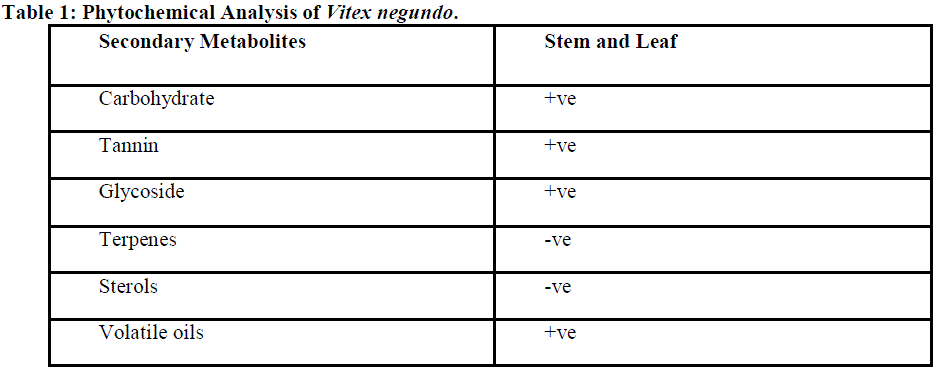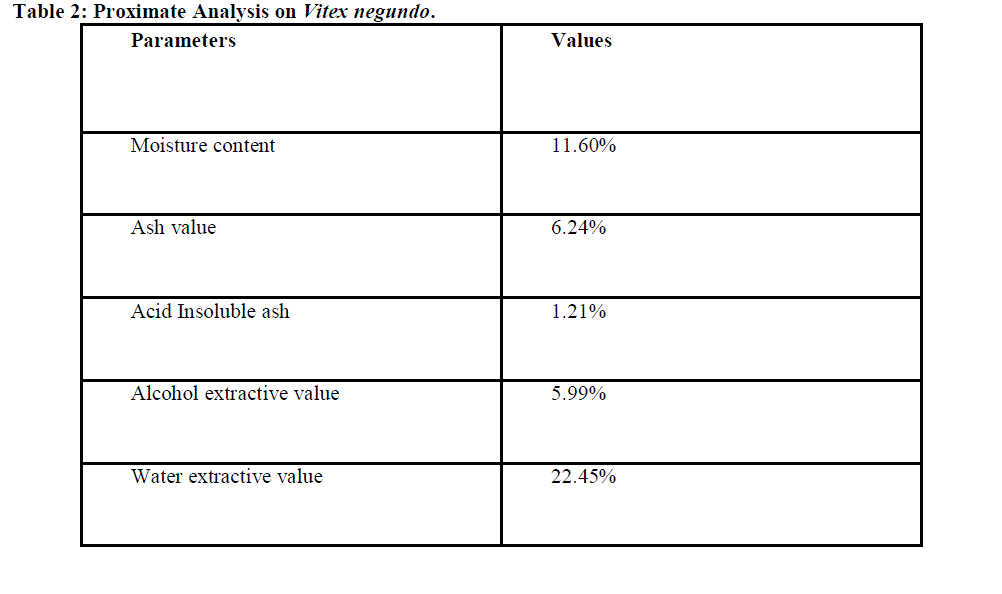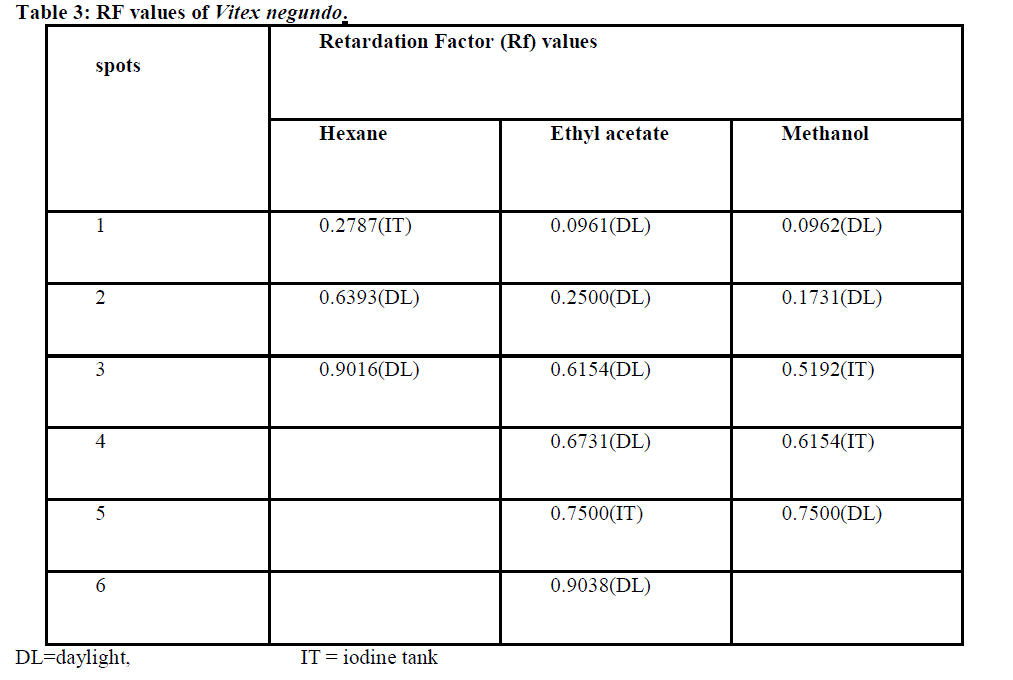ISSN ONLINE(2319-8753)PRINT(2347-6710)
ISSN ONLINE(2319-8753)PRINT(2347-6710)
| N.Nirmalkumar Department of Botany, V.H.N.Senthikumara Nadar College, Virudhunagar, Tamilnadu, India |
| Related article at Pubmed, Scholar Google |
Visit for more related articles at International Journal of Innovative Research in Science, Engineering and Technology
Phytochemical and pharmacognostic analysis and thin layer chromatography were carried out on, vitex negundo L. The phytochemical screening revealed the presence of phlobatannins, carbohydrates, tannins, glycosides, volatile oils, resins, balsams, flavonoids and saponins, while terpenes, sterols, anthorquinones and phenols were absent. The pharmacognostic analysis revealed moisture content of 11.60 %, ash value of 6.24%, water soluble extractive value of 22.45 %, alcohol soluble extractive value of 5.99% and acid insoluble ash of 1.21%. The thin layer chromatography development revealed three spots for hexane extract, six spots for ethyl acetate and five spots for methanol.
Keywords |
| Vitex negundo, phytochemistry, pharmacognostic, chromatography. |
INTRODUCTION |
| New drug discoveries have shifted attention from synthetic models and compounds to natural products of plants origin. This is because scientists now believe that drug leads/hit molecule discovery would be more probable in plant and other natural sources like marine and animals which are yet to be fully explored. This drift has promoted, in recent time, researches in plants considered to be of little or no economic or ecologic significance. Such plants like Vitex negundo L. is an important medicinal plant, and belongs to the family Verbanaceae. Vitex negundo is an erect shrub or small tree growing from 2 to 8 m (6.6 to 26.2 ft) in height. The bark is reddish-brown. Its leaves are digitate, with five lanceolate leaflets, sometimes three. Each leaflet is around 4 to 10 cm (1.6 to 3.9 in) in length, with the central leaflet being the largest and possessing a stalk. The leaf edges are toothed or serrated and the bottom surface is covered in hair.[2]The numerous flowers are borne in panicles 10 to 20 cm (3.9 to 7.9 in) in length. (Webster et al., 2005). |
| Vitex negundo is used for treating stored garlic against pests and as a cough remedy in the Philippines.[11] Roots and leaves used in eczema, ringworm and other skin diseases, liver disorders, spleen enlargement, rheumatic pain, gout, abscess, backache; seeds used as vermicide.It is also used to control population of (Jayvir et al., 2002; Hasan et al., 2009).. The plant is used as a diuretic, febrifuge, anti-inflammatory and laxative (Hong and Defillipps, 2000). Although some compounds such as n-octacosanol, n-triocotanol, stigma-sterol, compesterol, hydrocyanic acid has been reported to have been isolated from both the vegetative and flowering parts of the whole plant, there is no report in literature on the type of useful secondary metabolites contained in the plant which is considered as weed (Burkill 2000; Jayvir et al, 2002). A study of the types of metabolites found in the plant will encourage more research on the plant for possible drug lead. This study was aimed at revealing the classes of secondary metabolites which is found in the species of the plant in order to redirect focus on the usefulness of the plant for medicinal use. |
II. MATERIALS AND METHODS |
| The plant Vitex negundo was collected from Kadayam(Ramalingapuram) village in Tirunelveli district and identified at the herbarium of the SXC Herbarium –Palayamkottai., where a voucher specimen was prepared and deposited. |
| Plant Preparation: The fresh plant was rinsed with water to remove sand was air-dried for one month at room temperature. It was pulverized to reduce the surface area using wooden mortar and pestle. The pulverized sample was kept in air-tight cellophane bags until use. |
| Phytochemical screening and Pharmacognostic Analysis: These were carried out on the plant using standard methods (Evans 2002 and Sofowora 2008). |
| Thin Layer Chromatography: Successive extractions with hexane, ethylacetate and methanol were carried out on the pulverized sample by maceration for 24hrs. The extracts were filtered and concentrated on a rotary evaporator. Each concentrated extract was spotted on a normal phase plate previously activated at 110 0C for 2hrs, using a capillary tube. The plate was developed using mobile phase of hexane-ethylacetate (9:1) for hexane extract, and hexane-ethylacetate (3:2) for ethylacetate and methanol extracts. |
| The Retardation factor (Rf) was determined using this formula: |
 |
III. RESULTS AND DISCUSSION |
| The phytochemical screening carried out on Vitex negundo L. reveals the presence of phlobatannins, carbohydrates, tannins, glycosides, volatile oils, resins, balsams, flavonoids and saponins, while terpenes, sterols, phenols and anthraquinones were not detected. The presence of some of these secondary metabolites suggests that the plant might be of medicinal importance and supports the bases for some of the ethno-uses. For instance, the presence of flavonoids suggest that the plant might have an anti-oxidant, anti-allergic, anti-inflammatory, anti- microbial, anti- cancer activity (Kunle and Egharevba, 2009) It also suggests that the plant might have diuretic properties (Jayvir et al., 2002). |
| The presence of tannins shows that the plant is astringent as documented and suggests that it might have anti-viral and anti-bacterial activities and can aid in wound healing and burns (Haslem, 1989; Favel et al., 1994; Robertson and Heber, 1956). The presence of resins and balsams might support the ethno-use of the plant as emollient and demulcent as well as for treatment of sore throat, rheumatism, wounds and burns, since some balsams and resins has antiseptic properties (Evans, 2002). Saponins and glycoside are also very important classes of secondary metabolites as some are cardio-active and used in treatment of heart conditions (Oloyode, 2005). Some researchers have also reported that some saponins have anti-cancer and immune-modulatory properties (Kunle and Egharevba, 2009; Evan, 2002). Volatile oils are used in the industries for various purposes, both as a pharmaceutical/cosmetic raw material for production of emollients and demulcents as well as active ingredient for the respiratory tract infections. They are also used as flavoring agents, in aromatherapy, perfumery etc. Examples are eucalyptus oil, lemon oil and peppermint. Thymol has been reported to possess anti-bacterial properties (Evan 2002). |
 |
 |
 |
| The proximate analysis showed a moisture content of 11.60%, water soluble extractive value of 22.45%, alcohol soluble extractive value of 5.99%, total ash of 6.5% and acid insoluble ash of 1.21%. The moisture content of 11.60% which is normal since it is less than 20% and implies that the plant can be stored for a longer period with lower chances of microbial attack and growth. The water soluble extractive value of 22.45% which is higher than the alcohol soluble extractive value of 5.99% is suggest that water is a better solvent of extraction than alcohol. Total ash of 6.24% implies that the plant has low inorganic components probably as salts or complexes and a high organic component. The low acidinsoluble ash of 1.21% implies that a large portion of the ash content is acid soluble and hence may be physiologically important as salts in the body when consumed. It is also indicative of high digestibility of the plant when eaten. |
| The thin layer Chromatography reveals various spot from the different extract under daylight (DL) and iodine tank (IT). The TLC of hexane extract revealed 3 spots, ethylacetate extracts 6spots and methanol extract 5 spots. The Rf values are as shown in table 3 below. The spots correspond to the minimum numbers of compounds available in the various extracts. A spot may contain more than one compound as it may not have been fully resolved. |
| In conclusion, Vitex negundo, being rich in secondary metabolites as revealed in this study, might be of a very important medicinal value and should be investigated further for new drug hit/lead molecules. |
ACKNOWLEDGMENT |
| We acknowledge Mr. U.Chandran,Kadayam,Tamilnadu farmer who collected the plant and provided some information on the ethno-use of the plant. |
References |
|